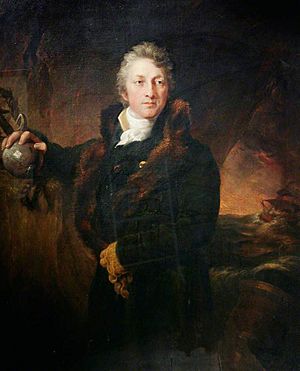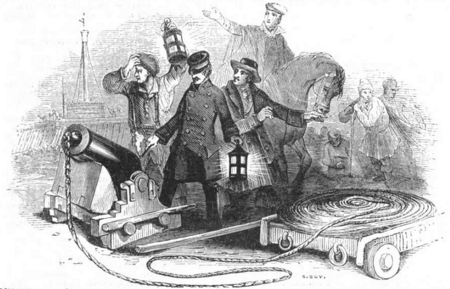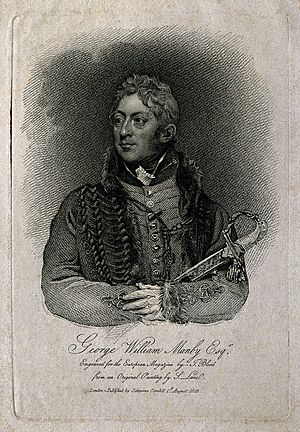George William Manby facts for kids
Quick facts for kids
George William Manby
|
|
|---|---|

George William Manby,
portrait by John Philip Davis |
|
| Born | 28 November 1765 Denver, Norfolk, England
|
| Died | 18 November 1854 (aged 88) Great Yarmouth, Norfolk, England
|
| Nationality | English |
| Known for | Inventor of Manby Mortar and fire extinguisher |
| Partner(s) | 1 Jane Preston, 2 Sophia Gooch |
| Parent(s) |
|
| Relatives | Thomas Manby, brother |
George William Manby (born November 28, 1765 – died November 18, 1854) was an English writer and inventor. He created amazing tools to save people from shipwrecks. He also invented the first modern fire extinguisher. He was known as Captain Manby and was a Fellow of the Royal Society.
Contents
Early Life and Education
George William Manby was born in Denver, a village in Norfolk, England. His parents were Mary Woodcock and Captain Matthew Pepper Manby. George had a younger brother named Thomas Manby.
He went to school in Downham Market. Later, he attended the Free Grammar School in King's Lynn.
Military Career
When he was 17, Manby wanted to join the army. He volunteered to fight in the American War of Independence. However, he was too young and small, so he was not accepted.
Instead, he went to the Royal Military Academy, Woolwich. In 1788, he became a Lieutenant in the Cambridgeshire Militia. He eventually reached the rank of captain. He left the regiment in 1793.
In 1793, he married Jane Preston. He later moved to Clifton, Bristol in 1801. There, he wrote several books, including The History and Antiquities of St David's.
In 1803, Manby wrote a pamphlet about Napoleon's plans to invade England. This caught the attention of the Secretary of War. Manby was then appointed as Barrack-Master at Great Yarmouth.
Inventing the Manby Mortar
A terrible event in 1807 inspired Manby's most famous invention. He watched helplessly as a Royal Navy ship, HMS Snipe, crashed near Great Yarmouth. Many people, including prisoners and children, drowned.
After this tragedy, Manby started experimenting with mortars. He invented the Manby Mortar. This device could fire a thin rope from the shore to a ship in trouble. A stronger rope could then be pulled to the ship. This allowed people to be rescued using a breeches buoy.
Manby showed his invention to the public in 1807. He did a successful demonstration in Lowestoft. In 1808, his device was used to rescue the crew of a brig at Yarmouth.
Public Recognition and Use
Manby received many awards for his life-saving invention. In 1808, he got a gold medal from The Society for the Encouragement of Arts, Manufactures, and Commerce. He also received a medallion from the Suffolk Humane Society.
He demonstrated his apparatus to the armed forces. The device was successfully used in rescues by Sea Fencibles in 1810.
Manby's invention was officially adopted in 1814. Many mortar stations were set up along the coast. It is believed that nearly 1,000 people were saved by his device by the time he died in 1854.
Manby also tried to build an "unsinkable" boat. During a test, the boatmen, who disliked Manby, rocked the boat until it flipped over. They may have worried that Manby's inventions would reduce their income from shipwrecks.
Other Inventions and Journeys
In 1813, Manby invented the 'Extincteur'. This was the first portable fire extinguisher. It was a copper container filled with a special solution and compressed air. He also invented a device to save people who had fallen through ice.
In 1818, he married Sophia Gooch.
In 1821, Manby traveled to Greenland with William Scoresby. He wanted to test a new type of harpoon for whaling. However, whalers on the ship sabotaged his device. He wrote a book about his journey called Journal of a Voyage to Greenland.
After his trip, Manby suggested that Britain should claim parts of East Greenland. He also thought this area could be used as a prison colony.
Later Life and Legacy
In 1823, the British Parliament gave Manby £2,000 for his life-saving equipment. The King of Denmark also gave him a gold medal.
Manby was present at the founding of the National Institution for the Preservation of Life from Shipwreck in 1824. This organization later became the RNLI (Royal National Lifeboat Institution). He was one of the first people to receive their gold medal in 1825. The King of Sweden also gave him a special medallion.
Manby was the first person to suggest having a national fire brigade. Some people consider him a true founder of the RNLI. He became a Fellow of the Royal Society in 1831 for his many achievements.
In 1838, Manby received a silver medal for protecting lives from fire. He also worked to get other countries to adopt his methods for saving shipwrecked sailors. In 1842, he received a Gold Coronation Medal from Queen Victoria.
Sophia, his second wife, died in 1843.
Retirement and Final Years
After his job as Barrack-master ended, Manby moved out of his home. He was a big fan of Horatio Nelson. He turned his new home, 'Pedestal House', into a Nelson museum. He even knocked down a wall to create a Nelson Gallery.
Manby's apparatus was shown at the Great Exhibition in 1851 and won a medal. In 1852, he donated some of his Nelson collection to King's Lynn museum. The Queen also gave him £100.
George William Manby died on November 18, 1854, in Great Yarmouth. He was 89 years old. He was buried in Hilgay.
Awards and Recognition
Manby received many awards for his inventions and efforts to save lives:
- A Gold Coronation Medal from Queen Victoria.
- Gold medals from the Kings of France, the Netherlands, Denmark, and Sweden and Norway.
- Gold medals from the Royal National Institution for the Preservation of Life from Shipwreck and the Society of Arts.
- A gold medal from the Highland Society of Scotland.
- Silver medals from the Royal Humane Society, the Suffolk Humane Society, the Norfolk Association for saving Lives from Shipwreck, and the Society for the Protection of Life from Fire.
Lasting Impact
Manby's work had a lasting impact. His portrait was shown at the Royal Academy in 1808. A plaque in All Saints church in Hilgay honors him. It says he is a name to be remembered as long as there can be a stranded ship.
A lifeboat in France was named the Captain George Manby. The Hilgay village sign also features a Manby Mortar.
In 1967, a documentary was made about his life and inventions. A Blue Plaque marks his birthplace in Denver. A restaurant in Great Yarmouth is named 'Captain Manby'. His former home, 'Manby House', is now a listed building.
Images for kids
See also
- Coastguards of Yesteryear: "Manby Mortar or Rocket Apparatus"
- Henry Trengrouse
- Gunville#John Dennett, rocket inventor




